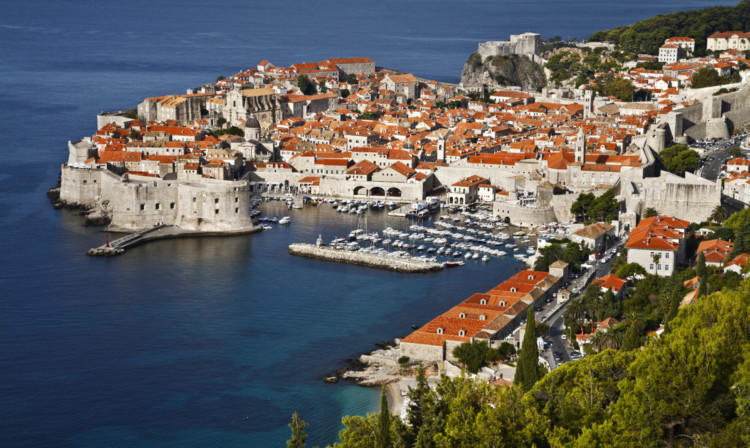
Croatia’s jewel of the Adriatic is a gem.
Dubrovnik is a stunning ancient town on Croatia’s beautiful Adriatic coast.
This UNESCO World Heritage Site provides holidaymakers with the chance to wander aimlessly around the Old Town, see a beautiful Franciscan Monastery, delve into designer shops, cafs and restaurants, or to see the terracotta-topped houses from the new cable car.
Dubrovnik really is a destination for all seasons where you can be inspired by breathtaking architecture, lose yourself in the quaint side streets, taste fine local wines, learn about the rich history with a guided tour, or even try your hand at harvesting oysters.
This area has a mild Mediterranean climate which is mostly warm and dry. The average temperature is 18C but the peak summer months of July and August get much hotter.
If you want to avoid the crowds and heat, spring and autumn are great times to visit, but if you’re interested in history and culture rather than beaches, any time of year is good.
Must-sees for free
Great pleasure can be had from exploring the beautiful stone streets of the Old Town, which shine like marble in the sun.
It’ll become clear why Lord Byron dubbed this place as “The jewel of the Adriatic”.
Don’t forget your camera so you can snap fantastic sites such as the Franciscan Monastery, Rector’s Palace and Dubrovnik’s Cathedral, or simply enjoy a coffee and watch the world go by in one of the many cafs along the town’s main thoroughfare, Stradun.
The Dubrovnik Cathedral of the Assumption of the Virgin Mary has existed in its present form since the early 18th Century, though legend has it that it was originally built thanks to a donation from King Richard the Lionheart after he survived a shipwreck near the island of Lokrum in 1192.
Dubrovnik is not only rich in culture, but also has several city beaches where you can enjoy the sea and sun.
One of the most popular is Banje Beach, where you can rent pedal boats to ride near the city walls, go jet-skiing or just relax on the sand.
Another option is the pebble beach of Sveti Jakov, which can be reached by bus.
Top sees for a fee!
No visit to Dubrovnik is complete without a walk around the city walls. It’s a great way to appreciate some of the city’s stunning architecture and escape the crowds.
The fortifications were built and rebuilt in the 13th, 14th and 15th Centuries and at some points the walls are almost 20 feet thick and 82 feet high.
You can complete it briskly in an hour or take a whole afternoon with a couple of pit stops at cafs along the way to keep you refreshed.
Dubrovnik cable car
Those who like a challenge could climb Mount Srd, which provides a breathtaking view over the entire city, surrounding area, sea and islands or you could take a cable car to the top, where you can enjoy the view from two terraces.
It takes around three minutes to climb 450 metres. I didn’t enjoy the 35 minute queue, but the views were worth it!
War Photo Limited
This state-of-the-art photographic gallery is in the historical centre of Dubrovnik and displays work by photojournalist Wade Goddard who worked in the Balkans in the 1990s, as well as several other exhibitors.
The museum aims to educate people in the field of war photography, and to “expose the myth of warto let people see war as it is, raw, venal, frightening, by focusing on how war inflicts injustices on innocents and combatants alike”.
Eating out
When visiting the area, be sure to try the Ston oysters, which are considered to be some of the tastiest and finest shellfish in the Adriatic.
Served raw, battered, grilled, in soup or in a risotto, Ston oysters are a local favourite. Feeling brave? Eel is a local delicacy. Try Brodetto, a red-coloured eel and frog stew, from the Neretva Valley.
One of the Dubrovnik’s most talked about establishments is Little Bistro Gil’s, which prides itself on using only local market-fresh produce within its ever changing menu and caters to everyone from families to food connoisseurs.
Top tips
The Stradun is lined with several souvenir shops, perfect for buying postcards or trinkets for friends. However, you may find some of the best boutique shops down its side alleys.
If you want to escape the hustle and bustle for a bit, take a shuttle ferry to Lokrum Island, a peaceful nature reserve perfect for relaxing and swimming in the inland sea. You can also visit the botanical garden and Benedictine Monastery.

Enjoy the convenience of having The Sunday Post delivered as a digital ePaper straight to your smartphone, tablet or computer.
Subscribe for only £5.49 a month and enjoy all the benefits of the printed paper as a digital replica.
Subscribe